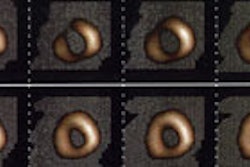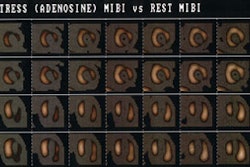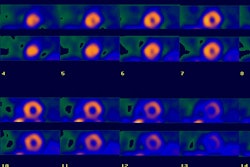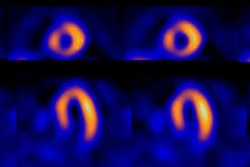Segmental pattern of myocardial sympathetic denervation in idiopathic dilated cardiomyopathy: relationship to regional wall motion and myocardial perfusion abnormalities.
Parthenakis FI, Prassopoulos VK, Koukouraki SI, Zacharis EA, Diakakis GF, Karkavitsas NK, Vardas PE.
BACKGROUND: Iodine 123-labeled metaiodobenzylguanidine (MIBG) has been used to study cardiac adrenergic nerve activity. Cardiac MIBG uptake is diminished in patients with heart failure. However, it is not known how this reduction is related to regional abnormalities of myocardial wall motion or perfusion. METHODS AND RESULTS: We studied 24 patients with idiopathic dilated cardiomyopathy (ejection fraction <45%) and 15 healthy control subjects using I-123 MIBG cardiac imaging, echocardiographic assessment of wall motion abnormalities, technetium 99m sestamibi perfusion scintigraphy, and hemodynamic assessment. Cardiac MIBG was significantly correlated with ejection fraction (r = 0.67), cardiac index (r = 0.57), left ventricular wall motion score index (r = -0.68), and systolic wall stress (r = -0.61). MIBG was lower in patients than in control subjects (1.43 +/- 0.19 vs 2.05 +/- 0.02; P <.01), whereas the washout rate was higher (P <.01). Moreover, a significant correlation was found between the reduction in MIBG uptake and the severity of echocardiographic wall motion abnormalities in the anterior wall (r = 0.543), apex (r = 0.530), and septum (r = 0.675), as well as with the severity of decrease in resting myocardial perfusion in the anterior wall (r = 0.480) and septum (r = 0.580). CONCLUSIONS: Patients with idiopathic dilated cardiomyopathy show not only global but also regional abnormalities of cardiac sympathetic innervation. The severity of these changes is partially correlated with abnormalities of regional wall motion and myocardial perfusion.



